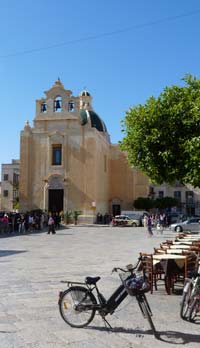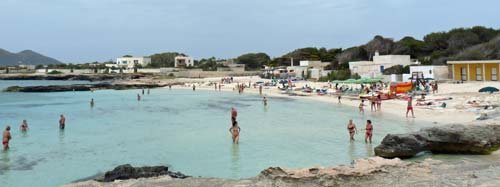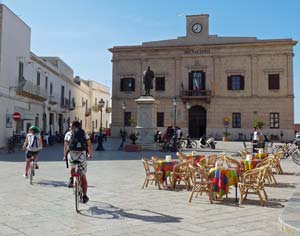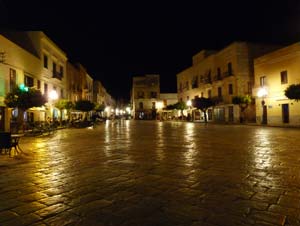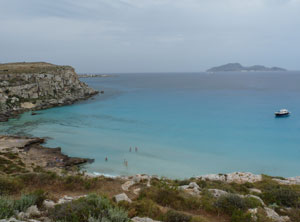Favignana: an introduction
Favignana (pronounced Favinyarna) is the largest and most significant of the Egadi Islands, a small group of islands off the west coast of Sicily. Favignana has good, frequent ferry connections with the other two inhabited Egadi islands, Levanzo and Marettimo, and with Trapani on the Sicilian mainland. Along with the proximity of Trapani Airport, this makes Favignana a very accessible and affordable island holiday destination. On this page you’ll find a detailed guide to visiting the island, with things to do, beaches, sights and historical context.
I’ve stayed on the island of Favignana twice. The first time was way back in 2010, ahead of a period of tourism growth. Although I found a much more busy tourist atmosphere when I returned almost fifteen years later in 2024, I felt that Favignana’s increased popularity hadn’t – yet – spoiled the island. Favignana was, and largely still is, a fairly low-key destination most visited by Italian holiday-makers.
Favignana may be busy with tourists in the peak summer months, but compared to Italy’s big-name touristy islands like Capri and Ischia, or the chic atmosphere of some of the Aeolian Islands, Favignana and its Egadi siblings still have a refreshing and simple authenticity. This is a great destination for those who want to swim in turquoise sea, cycle through an unusual landscape and enjoy seafood or pasta at picturesque street tables in the evening.
About Favignana: the island in context
Favignana’s shape is often compared to a butterfly; the island is composed of two wide, flattish stretches of land on either side of a high rocky spine, topped by a decaying fortress. Ferries arrive at Favignana town, the only substantial settlement on the island. The town is situated on the eastern side of the island, which is connected to the western side by a road tunnel through the hill which divides the two plains.
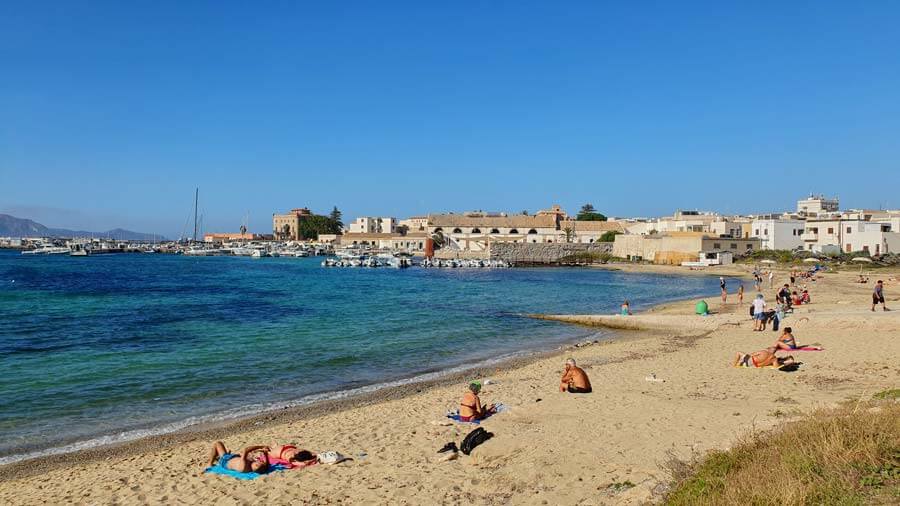
Favignana town is a cheerful place, with a real local atmosphere and a friendly attitude to the tourists who come to stay. The centre of town is pedestrianised for the evening passeggiata. In the main squares, Piazza Madrice and Piazza Europa, elderly men sit outside cafés passing the time of day, and children play on their bicycles while their parents do the shopping or stop for a chat.
Favignana’s history is a tale of rich and poor. The island of Favignana belonged to a wealthy family from Genoa for a couple of centuries, until it was purchased by the entrepreneurial Sicilian Florio family in the nineteenth century. The grandest house in town and the tuna processing plant across the harbour were both built by the Florio dynasty, who ran a successful tuna-fishing business on Favignana and are key figures in local history. A series of novels about the family became recent historical fiction best-sellers (Book 1: The Florios of Sicily – Amazon UK affiliate link), and there’s an Italian-language TV series too, The Lions of Sicily (see the American-dubbed trailer)
Tuna-fishing was hugely important around these islands. Favignana had until recently one of the last traditional tuna fisheries (tonnare) still operating in Sicily and in the wider Mediterranean. Travellers can learn about this heritage by reading on, and by visiting one of Favignana town’s chief tourist attractions when on the island, the Ex-Stabilimento Florio.
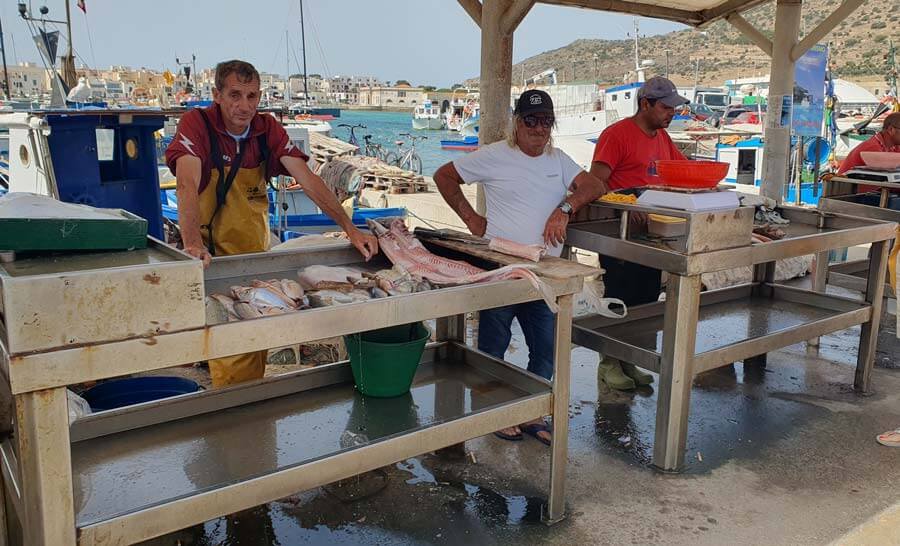
Battle of the Egadi Islands
While tuna fishing and the Florio connection are dominant features of Favignana’s history over recent centuries, the most famous historical event of the islands took place over two thousand years ago. On the 10th March 241 BC the Roman fleet defeated the Carthaginian navy in the Battle of the Egadi Islands, which was fought in the seas around the islands. The Romans’ nautical victory was key in bringing the First Punic War to an end. There’s a local tale that Favignana beach Cala Rossa (Red Bay) is named for the blood of the battle’s victims washing up on the shore. Today in Favignana you can buy souvenir T-shirts referencing the battle, ideal for history lovers (yes, I bought one).
A riveting archaeological sequel to the Battle of the Egadi Islands has taken place over the last couple of decades. Thanks to archaeological detective work and marine exploration (with some help from the discovery of illegal loot), the location of this ancient conflict has been narrowed to a stretch of water off the island of Levanzo. And divers have recovered remarkable relics from the Roman and Carthaginian warships that fought here.
A bronze battering ram/rostrum projected from the prow of a fighting ship to assault enemy vessels. Among amphorae and other ‘typical’ remains of shipwrecks, these rams began to be discovered on the seabed. Several contain fragments of wood from the ships they ‘rammed’ in battle. They bear names and other decorations, making them even more fascinating to historians. These and other finds are still being discovered at the time of writing (read an article about the history and discoveries). A large room in the Ex-Stabilimento Florio museum on Favignana contains a collection of rostra (rostri in Italian) along with associated displays. It’s a remarkable place to visit.
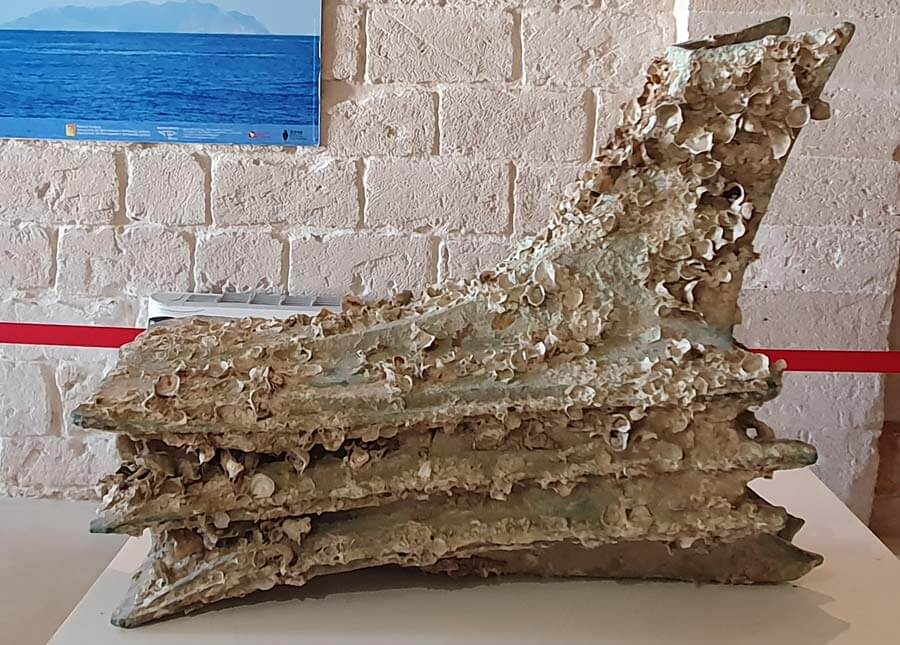
Quarries TO gardens
Favignana’s disused calcarenite limestone quarries are a remarkable feature of the island. Some – including one which I visited on the north-eastern coast and another at Cala del Bue Marino – are caverns with vast, cathedral-like interiors. Others consist simply of large excavated pits where the bid for short-term profit has eaten away the surface of the island. In some places you’ll find the road and isolated houses are left standing on ‘plinths’ with the land around them dug away to a depth of several metres.
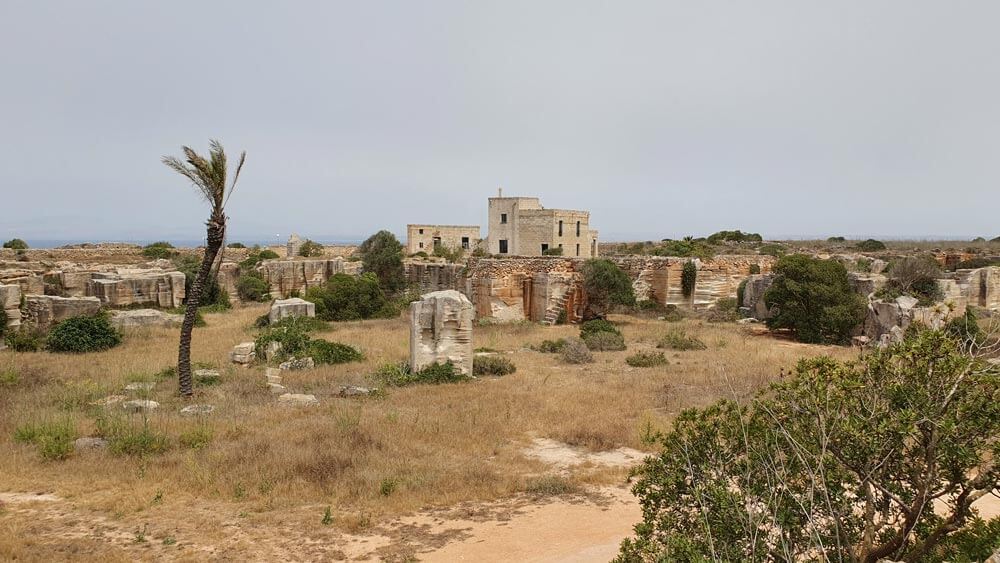
The history of quarrying on the island goes back over two thousand years, to the time of the Phoenicians. Romans and Arabs also quarried the stone here, though much of the digging we see evidence of today took place between the 17th and mid-20th centuries.
Some of the open, excavated spaces on Favignana are now cultivated and used for gardens or allotments, though it’s a battle against arid conditions. With their stone columns and stairways these are truly bizarre and memorable sights. A fantastic example of a quarry garden, the Giardino dell’Impossibile, is open to the public and it’s a Favignana must-see (details below). During a tour of the garden, you learn more about the history behind the quarries and the pirriaturi, the men who worked in them.
Favignana: tuna and la Mattanza
Each year in May or June, when tuna fish would migrate in large numbers past the islands, the fishermen of Favignana took to their boats to entrap them. This involved capturing tuna in a sequence of nets culminating in the ‘Chamber of Death’ where the fish were pulled to surface and bludgeoned to death in a famous and gory spectacle called the mattanza. The mattanza was conducted according to traditional rules, which included special working songs and ancient rituals.
Favignana’s mattanza was controlled by a leader called the rais, who was the holder of generations of tuna wisdom and superintended the timing and operation of the ritual slaughter. In its later years the mattanza became a tourist attraction, viewed by visitors and featured in bloodthirsty postcards. The last mattanza in Sicily took place here in 2007. Nowadays the museum in the former tonnara (see below) records this part of the island’s past, and it’s an unmissable destination for visitors interested in local history and these important vanishing Mediterranean traditions.
Things to see and do on Favignana
Discover Favignana town
Favignana is a great place to absorb island atmosphere as you stroll around the little town. The atmosphere is mellow and welcoming, with lots of unpretentious charm to soak up. Most of the island’s shops and food businesses are clustered in just a few streets in the centre of town, near the harbour. The two attractive town squares are divided between civic and religious authority: the wide Piazza Madrice is the site of the principal island church, the Chiesa Madrice, while smaller Piazza Europa is dominated by the town hall, the Municipio.
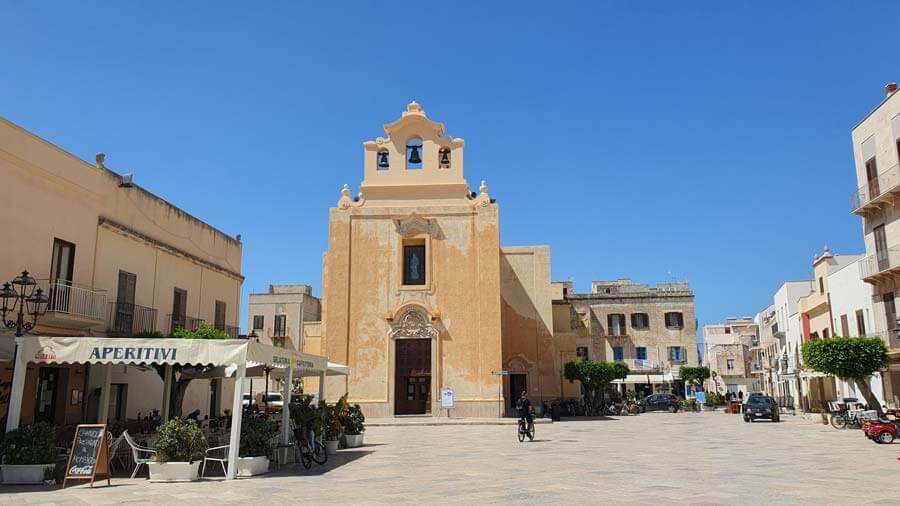
Around these piazze and the lanes alongside you can find souvenirs, gelati, street food, restaurants, bars, bakeries and other essential services including a pharmacy. In addition to foodie shops, you can find fishermen selling their fresh catch from stalls and the back of ape trucks by the harbour.
The town is situated at one side of a deep bay forming a natural anchorage. Ferries and pleasure boats use the port next to the town centre. Boats bob in the waters, there are scenic views, and for those who don’t want to travel further, there’s a stretch of sandy beach at the back of the bay (for more on beaches and swimming, read on).
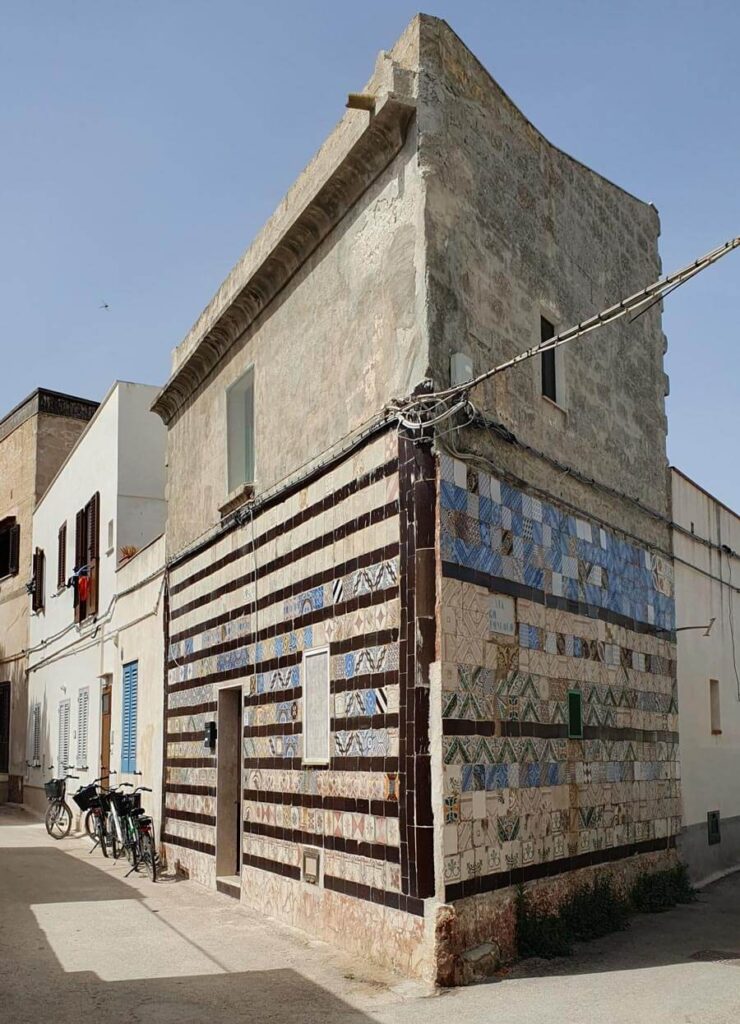
The island’s tuna-fishing heritage is ever-present, from the tuna products in shops to the town’s grandest buildings, the tuna fisheries. The large complex of the Stabilimento Florio, over the harbour from the centre of town, has been zealously restored thanks to EU funds, and now houses a museum, which I’ve described separately below.
The waters around the islands form a protected marine reserve, and you can learn more about this by visiting Favignana’s rescue centre for sea turtles, at the ex-Stabilimento museum site, with a separate entrance. It has limited opening hours, so check ahead: Centro Recupero Tartarughe Marine AMP Isole Egadi
Ever since the Roman era, Italians have used their offshore islands as prisons, and Favignana still fulfils this function. A maximum security prison notorious for its conditions was housed in a star-shaped fortress called the Castello San Giacomo, which was rebuilt in the Aragonese era over an earlier Norman castle. In 2011 prisoners were moved to a modern prison nearby, and the historic castle is crumbling and awaiting future developments at the time of writing. Hopefully it will be open to the public. All that can be seen in the meantime are the high external prison walls. Interesting murals are painted on these: a Madonna of the Calvary by Sicilian street artist Igor Palminteri, a sorrowful tribute to the island community of tuna fishers and maritime workers, and a mural commemorating self-taught island sculptor Zu’ Sarino by artist Loste.

Imposing in a wholly different way is the elegant villa built by the Florio family between the town centre and the port, Palazzo Florio (AKA Villa Florio). This is also worth visiting and again I described it in more detail below.
The town centre isn’t large, and it’s worth roaming around to enjoy the picturesque lanes and charm of its buildings. Interesting sights include the statue of Ignazio Florio, businessman, owner of the islands and benefactor, in Piazza Europa. Facing the statue, look out for a plaque commemorating the victims of a Second World War air raid. Allied planes bombed the island on 6th May 1943, killing 101 residents.
Museum: Ex Stabilimento Florio delle Tonnare di Favignana e Formica / Museo della Tonnara
This museum, which goes by various permutations of the name above, is a fascinating destination offering insights of various kinds into the island’s history. The Museo della Tonnara (Museum of the Tuna Fishery) is housed in the Stabilimento Florio (or Ex-Stabilimento), the large industrial complex built on the waterfront over the bay from the heart of Favignana town, its great arched water entrances forming one of the town’s most striking views.
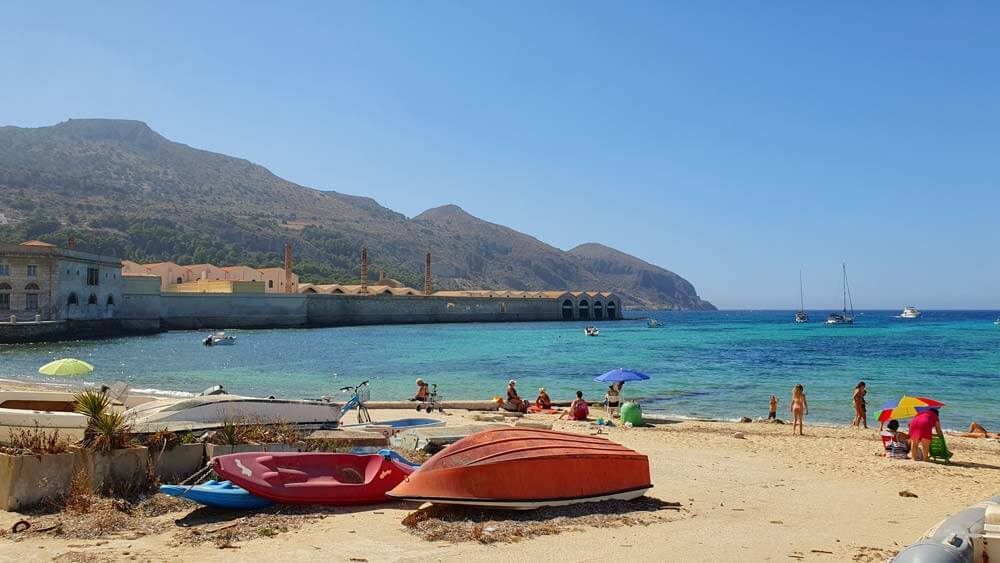
The Stabilimento was a tuna-processing plant, originally founded in 1859, developed by Vincenzo Florio and later reacquired by his son Ignazio Florio, who bought not just the factory and the fishing rights, but the entire archipelago of the Egadi islands.
Among many other commercial interests, the Florios pioneered the preservation of tuna in oil, and canning fish. Risen to great wealth themselves, they brought jobs and money to Favignana, placing the island at the forefront of industrial development. As I looked at a T-shirt depicting famous socialite Donna Franca, wife of Ignazio’s son Ignazio Junior, a shopkeeper in town told me that the time of the Florios were great days for the island: work and prosperity, “but unfortunately she had a fondness for gambling.”
Although visitors can walk around the Stabilimento museum independently, there weren’t as many interpretation boards as I’d have liked and if you have a serious interest, I’d recommend visiting on a guided tour to gain a better understanding. On your own, though, you can still appreciate the spaces where the tuna catch was landed and processed, the industrial heritage on display and a miniature reconstruction of the complicated system of nets used in the the mattanza.
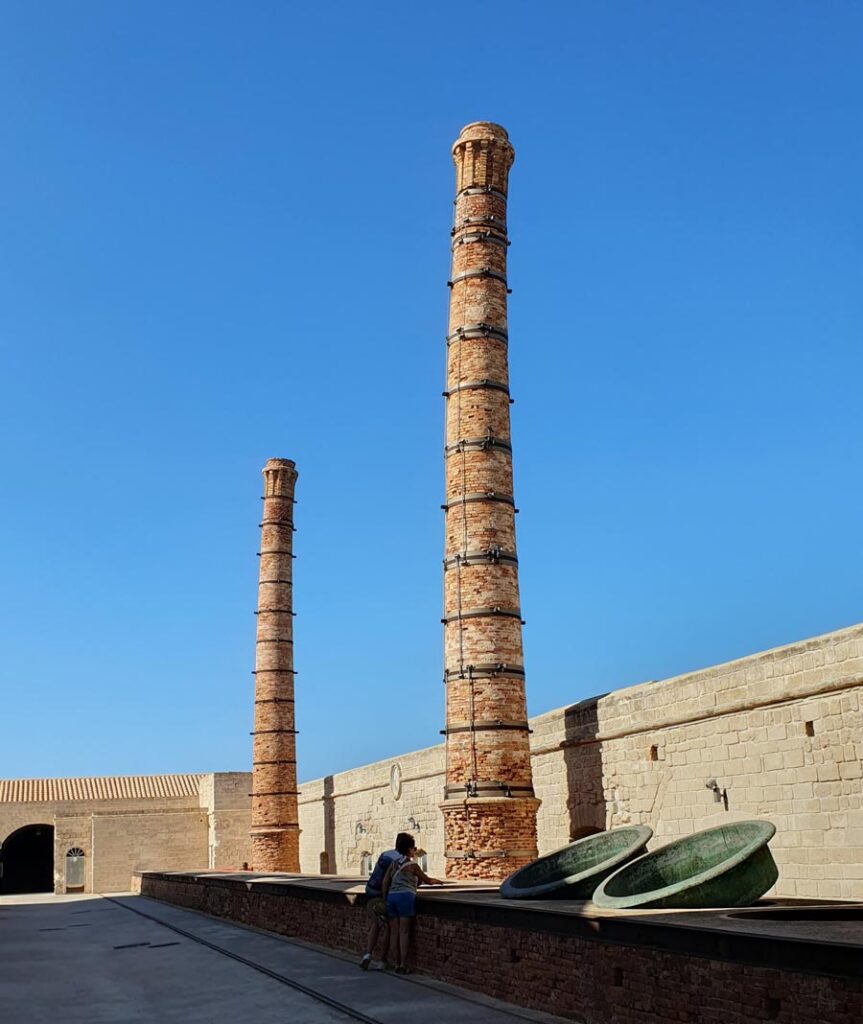
Other sights to see here include boathouses and boats, men’s and women’s changing rooms (the women’s still contains an inscription from Italy’s Fascist era), photo exhibitions, displays of tuna cans in the hall where the tuna was processed, contemporary art installations, fishing nets and recordings of traditional songs of the mattanza.
The museum provides a moving and fascinating monument to the men and women who worked at sea and in the Stabilimento, and the industry that until so recently was still a living heritage. Our islander guide had personal reminiscences and strong feelings over the legislation, fishing quotas and choices that led to the end of large-scale tuna fishing here.
I found the tour and the island heritage it brought alive to be fascinating. I made a lot of notes with accompanying photos; too much to write up in this general guide to the island, but which I may include in a blog post if I have time (which I’ll link here). I timed my visit to allow myself time to look at the archaeological displays at my leisure before joining a guided tour.
The reason I wanted extra time? The museum doesn’t just cover the history of tuna-fishing; the archaeological section is also extremely interesting. The obvious highlight is the Sala dei Rostri, a large room displaying the rostrum collection found on the seabed dating to the Battle of the Egadi Islands (described above). A number of the rostra are displayed here; evocative links to the ancient sea-battle and a world of warfare so different to the modern one. (The shady room was also a haven for mosquitoes when I visited, so cover up!)
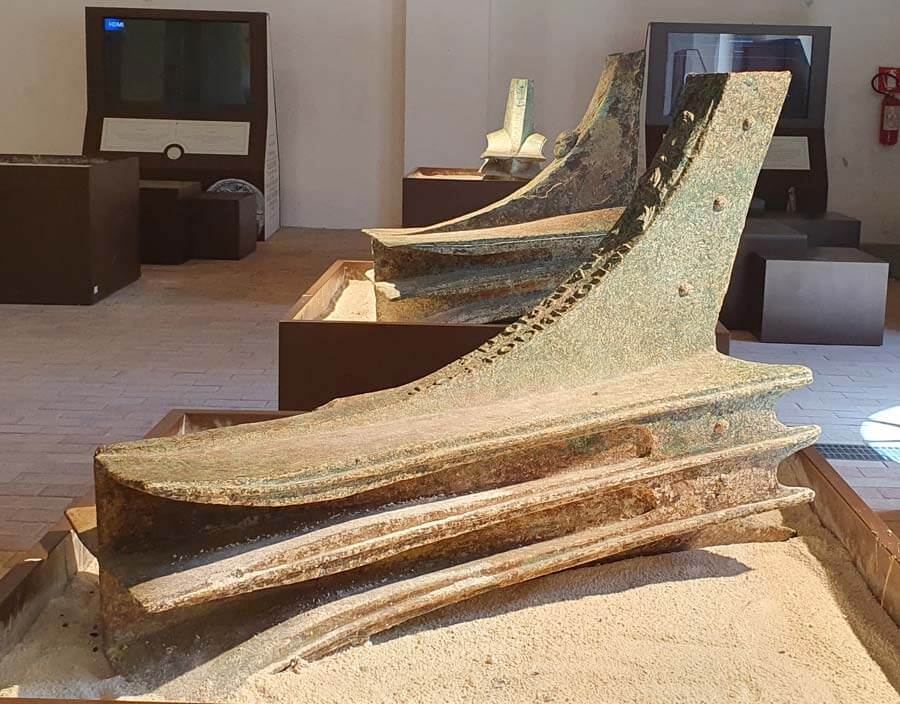
Other archaeological rooms offer display cabinets, videos, information boards and a recreation of seabed used to display ancient finds. Exhibits on display when I visited (some may have been part of a temporary exhibition) included helmets, unrestored, encrusted rostra truly looking as though they had emerged from the sea after millennia, and a variety of finds from shipwrecks of different eras.
Check the opening times before you head along to the Stabilimento, and I’d suggest getting in touch in advance for an English-language guided tour. If you plan to visit on your own, reading up a little in advance would be a useful aid for interpreting what you’ll see. Visiting details and contacts: La Tonnara di Favignana: Stabilimento Florio
Palazzo Florio
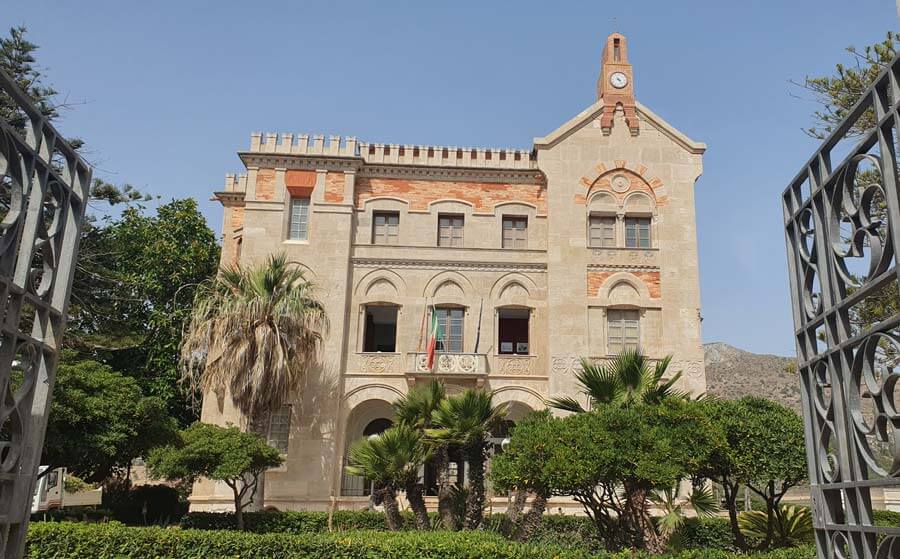
The Florio family’s elegant villa is set in its own gardens, a little oasis in the town. The building is open to the public (limited hours) hosting exhibitions and with a tourist information desk: Palazzo Florio (Comune di Favignana)
Ignazio Florio commissioned architect Giuseppe Damiani Almeyda to build this island base for the family in 1874, when he purchased the islands. Inspired by a medieval castle and including the family emblem of a lion in its décor, the palazzo is filled with a sense of past and faded glories: the grand staircase, the stucco decoration, the windows and balcony with views over the island and the industries which belonged to the family, ghostly memories of the days when the Florios would arrive on their glamorous yacht to entertain guests here.
When I visited the villa’s displays included photographs of the glory days of the Florio dynasty as well as replicas of dresses worn by the famous beauty Donna Franca, including a recreation of the dress she wore when painted by Boldini.
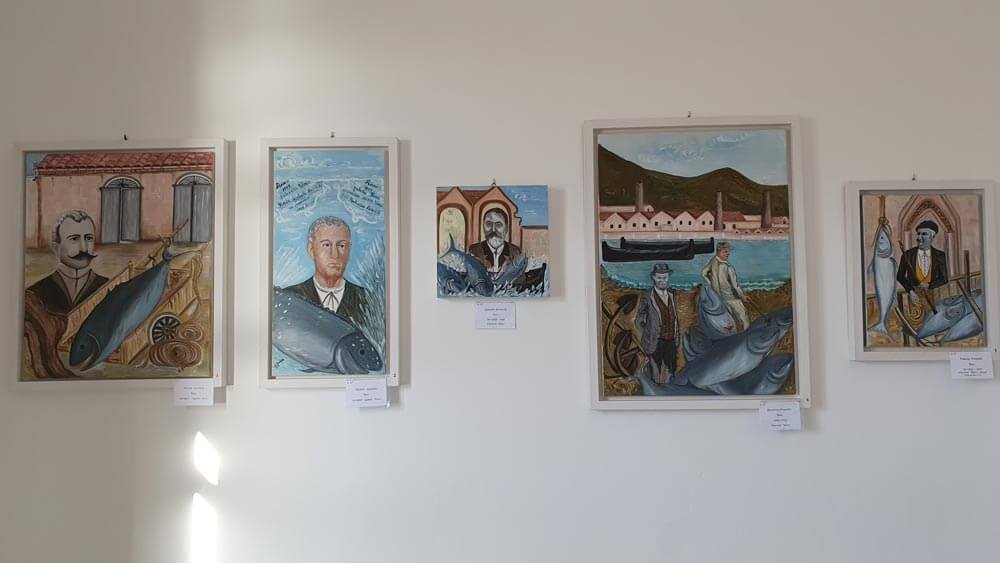
On a different note to the glamour, the Sala dei Rais is a room containing portraits by Giovanna Guccione of the men who held the position of Rais of the Tonnara, the mattanza leaders, a charming and compelling tribute to these almost-mythological figures in the island’s history.
Explore the island by bike
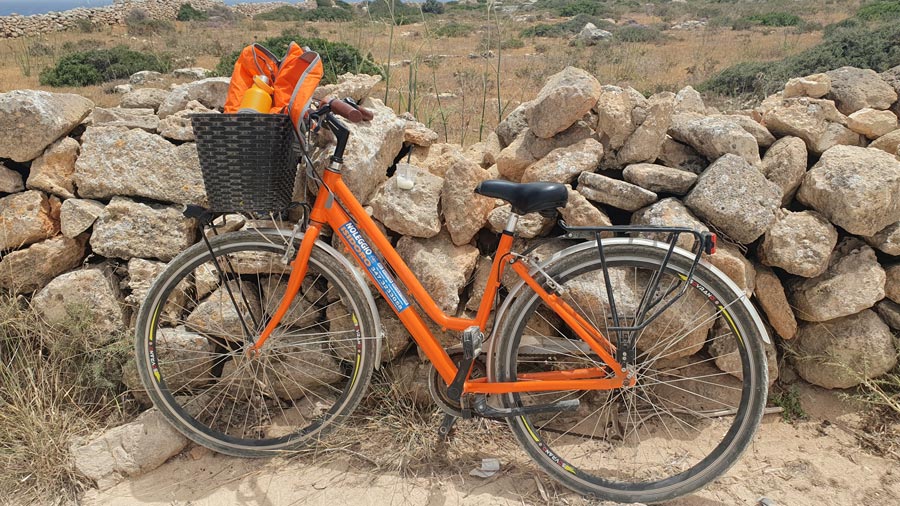
Favignana’s mostly-flat landscape and scarcity of traffic make the island an ideal place to tour by bike. There are many competing shops at the port and in town offering cheap bicycle rental (noleggio bici), with e-bikes also available. You should take a passport or similar document to hand over as a guarantee.
Get hold of a simple map, or follow the coastline, and you can sail along empty roads, and bump along scenic tracks to discover the remoter parts of the island and reach secluded coves. I used a basic map from my hotel and also Google Maps (my Google Map of Western Sicily and the Egadi islands has pins and annotations you might find useful if you zoom in on Favignana). I would recommend finding a more detailed map, though, if you are staying longer, exploring, hiking, or wanting to familiarise yourself more thoroughly. I believe there are also organised guided tours by bike, though that way you would lose the sense of adventure and freedom.
Keeping to the the eastern half of the island, in less than a full day you can cycle to dramatic quarries, several beaches and rocky coves, marvel at the bizarre excavated landscape caused by quarrying, explore the ‘Impossible Garden’ and visit a picturesque fishermen’s hamlet.
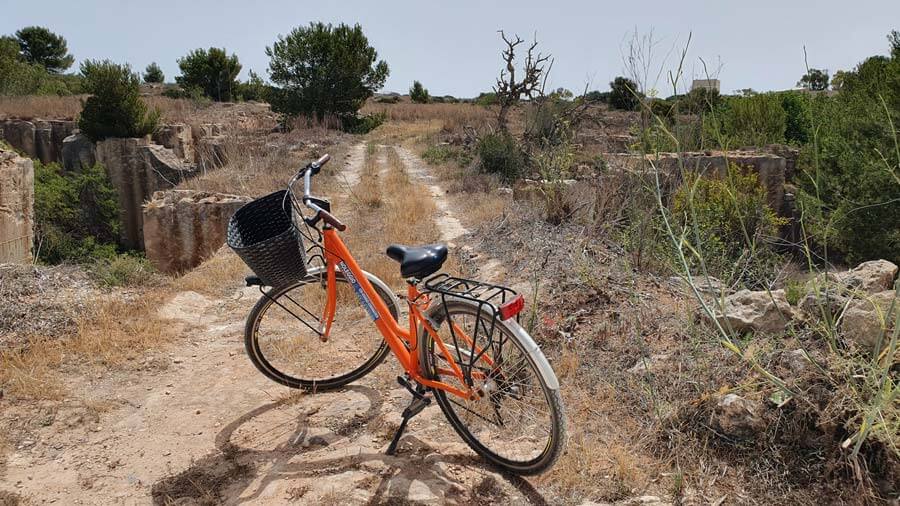
While experienced cyclists will have no trouble here, apart from perhaps summer heat, I approached my bike ride as a challenge. As a wobbly and unpracticed cyclist I found controlling my hired bike, with my heavy rucksack in its basket, hard work at times. One inland route towards the quarry garden was particularly bumpy and dusty, and at one point the lack of a detailed map left me pushing my bike up a sloping rocky path after going in search of a scenic short cut. Nonetheless cycling is by far the best way to discover the island beyond the town, to reach coves and beaches and to get to know the landscape, and even I enjoyed myself overall.
Sailing along the better-surfaced country roads past dust-coloured cows, dry stone walls and picturesque quarries before arriving by the sea can be an absolute joy even for a novice like me. A couple of jays flew across the lane towards a picturesque farmhouse, I was heading for the sea, and life felt perfect. On a hot day the breeze while cycling was welcome. Just be sure to take plenty of water and sun protection, as well as your beach stuff and maybe a picnic lunch from a town bakery (hence my heavy bag). There aren’t many sources of food or drink outside the town, and few services.
Favignana Beaches
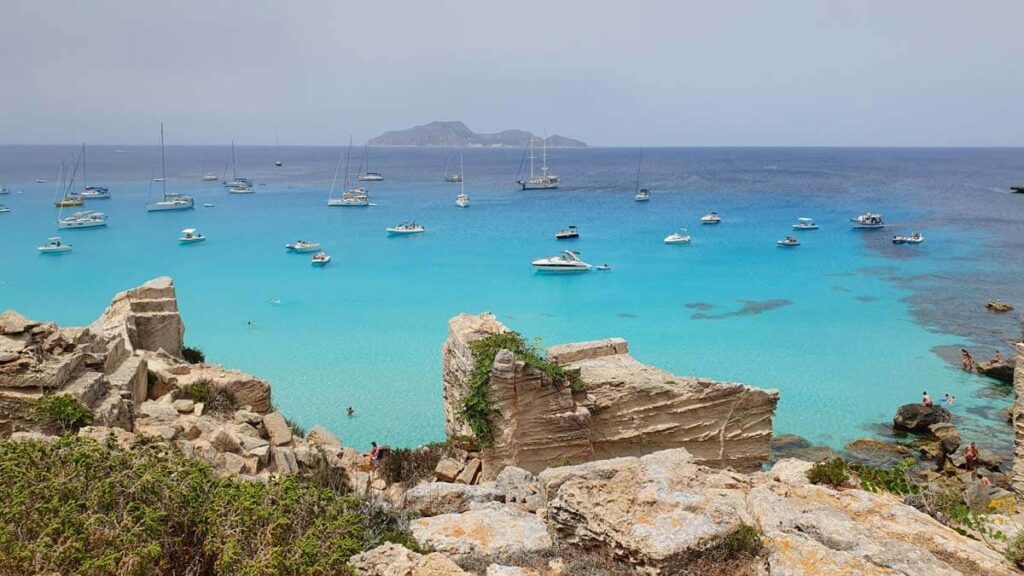
Favignana has a number of small beaches and rocky bathing places. The sea, of course, is one of the main attractions of an island trip. Foreign visitors should note that, as is often the case in Italy, some of the most popular ‘beaches’ can be adventurous, rocky and fairly hard of access. With the exception of the town beach, I reached all the bathing spots below by bike. They’re also reachable by boat and I discuss getting around the island a bit more further down this page.
On an Italian island I’d always recommend consulting with your host or hotel receptionist when it comes to planning a beach trip. They’ll be able to recommend the best beaches for the day based on wind direction and local conditions (seaweed, jellyfish etc.). Making a tour of Favignana by bike or other transport on your first day is also a good way to check out the coastline and pick your favourite destinations to return to at leisure during a longer stay.
Spiaggia Praia
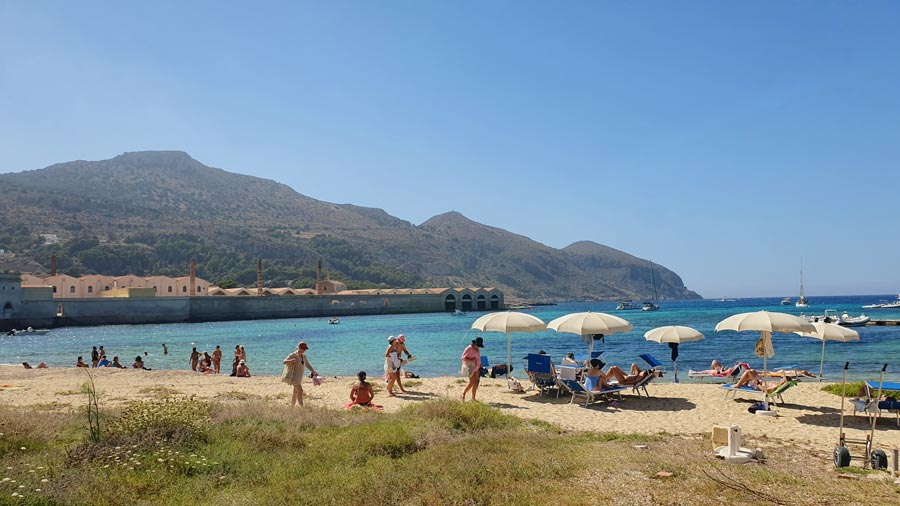
The nearest and most convenient beach for visitors or locals wanting to soak up the sun is Spiaggia Praia on the edge of the town centre, on the way to the Ex-Stabilimento. Bathing wasn’t permitted at the time I visited, and I don’t imagine the water here, so near the port, can be the cleanest. But this sandy beach is in a useful location, especially if you just want to take a short break relaxing in the sun. When I visited, there were sunbathers enjoying the rough sand and the lazy beach vibes. There’s an attractive little beach-shack bar at the town centre end of the beach which must be a great place to while away island hours with an aperitivo.
Cala Rossa
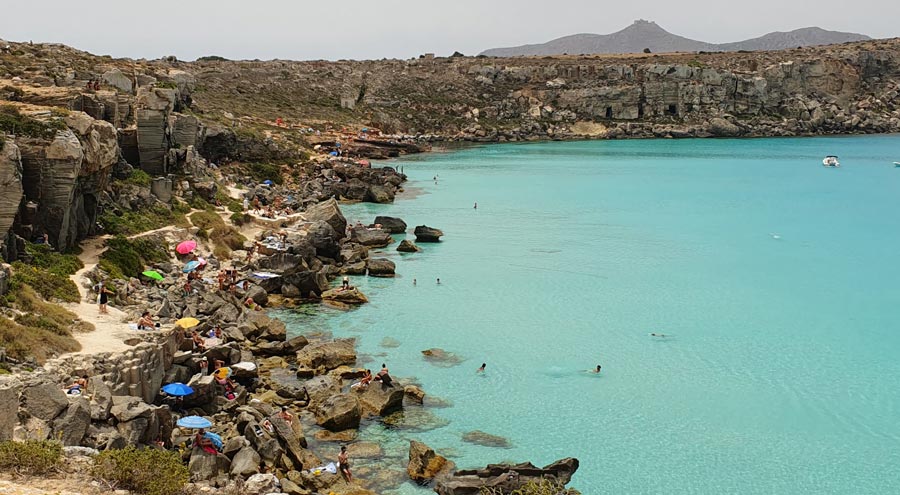
The most sought-after bathing spot on Favignana is picturesque Cala Rossa, a wide and rugged bay backed by rocky cliffs. Off Cala Rossa the sea is typically a glorious shade of turquoise, one of the ingredients making this bay famous and hugely popular with Italian holiday-makers. Visitors turn up on bicycles, scooters or in boats to drape themselves over rocks, clamber into the sea or wade out from the scrap of sandy beach. It’s quite a scramble to get down the low cliffs and rocks to the sea, but determined Italian swimmers and sun-seekers don’t let this deter them.
Although this is a fairly primitive seaside experience, there is a shack bar on the cliffs at the eastern end of the bay, Robertino’s, where you can buy pane cunzato, rolls and drinks.
Lido Burrone
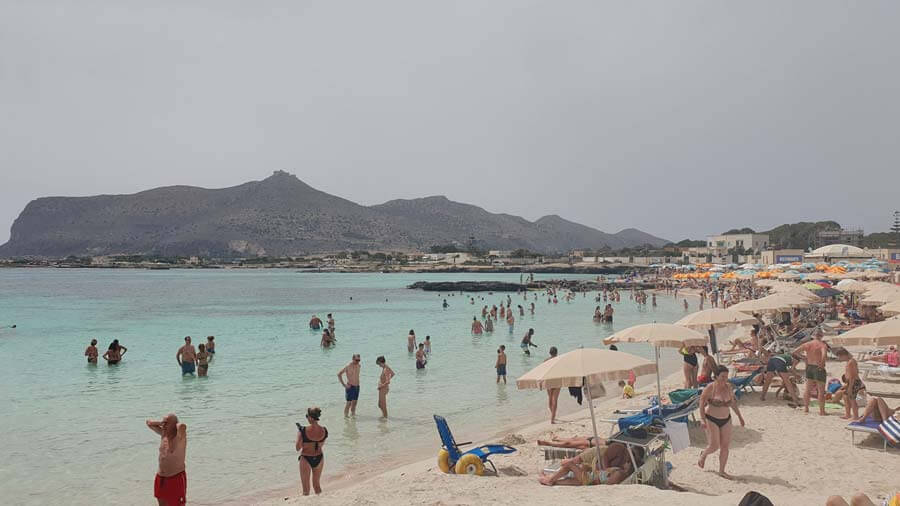
A much more comfortable beach experience can be enjoyed at Lido Burrone, a wide sandy beach with easy access. The scenery isn’t as dramatic and the sea may not be quite as wonderfully turquoise as Cala Rossa, but at Lido Burrone you’ll find bars, restaurants, and facilities including sun-beds and parasols for rent. You can stay here too – check my accommodation recommendations further down this page.
This is a family-friendly seaside destination, and only a short bike-ride from the town. If you’re looking for a traditional beach experience this is the place to come. The sand beach at Lido Burrone descends slowly and gradually into shallow sea, making it ideal for the popular Italian beach pastime of standing around in the water to keep cool, while socialising and chatting (often about your last or next meal).
I like the old rock bridge and jetty and hidden pool/cove at the left-hand end of the beach as you face the sea; especially attractive if you’re not spending long enough here to want to pay for a lounger or get sandy.
Cala del Bue Marino
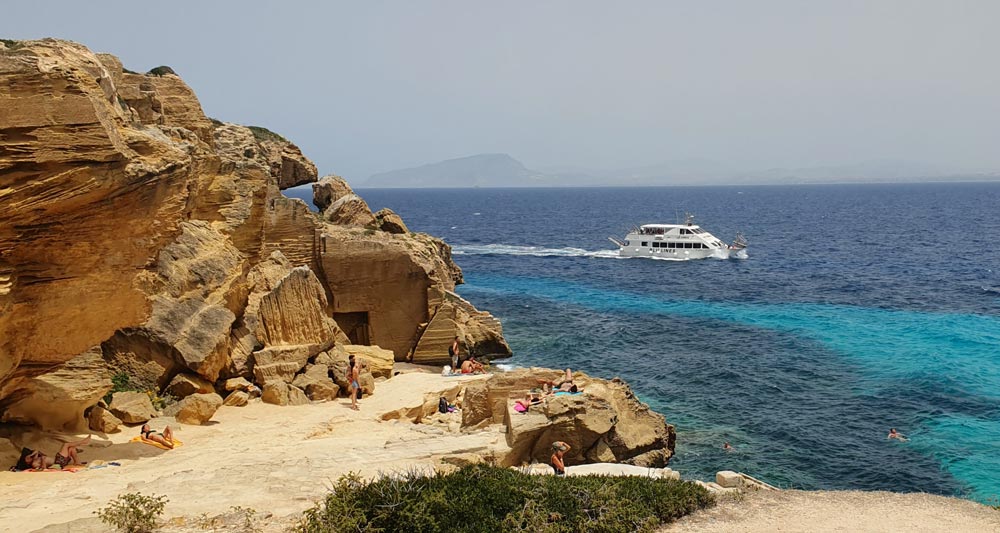
Back from seaside ease to seaside drama, on my recent trip I took a break from cycling at Cala del Bue Marino (or Spiaggia Bue Marino). At the eastern end of the island, this is another cliffs/rocks/turquoise sea experience: no services apart from a food van or two. This is a bathing place for confident and able-bodied swimmers – the sea is reached by descending from rocks.
I’d recommend Cala del Bue Marino as a picturesque destination on a Favignana tour, though, even if you’re not planning to swim. I found visiting a pretty special experience. On the clifftop I propped my orange bike against a dry stone wall and explored. A rough track slopes down towards the sea, passing the mouth of a cavernous quarry. Sunbathers had found strategic spots on rocks, while other visitors had picked shady spots near the quarry mouth to avoid the hot sun.
Walking deep into the tall quarry tunnel was hugely atmospheric, as was emerging once more to the sunshine and the sight of the sea. There would have been some kind of infrastructure here,or at least rocky ramps, to load the quarried stone onto boats, and these rough rock platforms now offer access to the sea for swimmers who aren’t daunted by the tricky access.
Climbing back uphill, I bought lunch from the van on the clifftop (specialising in tuna rolls; I had a vegetarian pane cunzato) and found a ledge with sea views and a little shade to enjoy my picnic. Before I cycled off on the next leg of my tour, I picked up a cold and refreshing lemon granita (ice drink) from the giant lemon trailer nearby.
Cala Azzurra
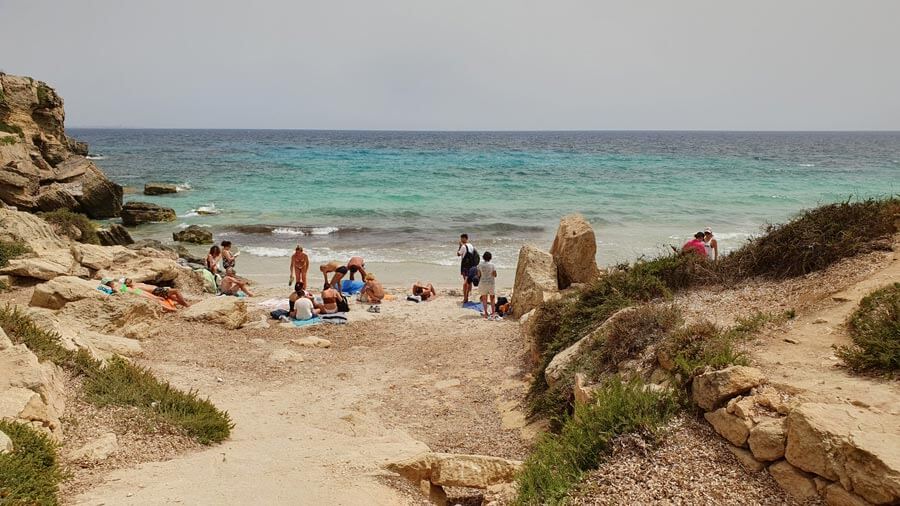
Cala Azzurra, ‘Blue Bay’, is a small beach in a wide bay in the south-western corner of the island. There’s a bit more cycling/travel to get here along the island roads, through farmland and scenery that’s relatively unspoilt. A few scattered hotels and holiday developments have grown up in this part of Favignana, but there’s still a rural feel. Cala Azzurra is reached by a road which heads for the lighthouse at Punta Marsala. There’s a small car park alongside the road, and a path leading the short distance down to the beach. Over the road is a bar selling food, the Risto-Bar Cala Azzurra, a rare and useful stop for refreshments/services outside the town.
The beach at Cala Azzurra is pocket-handkerchief sized, a small patch of pale sand with rock and earth ledges offering further space for sunbathers. When I visited, tides and an onshore wind had washed up banks of dry Posidonia, a Mediterranean seagrass which thrives in the marine reserve around the Egadi islands – a healthy sign of clean waters, though not ideal for beach users.
Being further from town means that Cala Azzurra is likely to be less busy than the famous Cala Rossa. Offering some actual sand and gentle sea access gives it some advantage over both Cala Rossa and Cala del Bue Marino, although it doesn’t beat the scenic impact of those two spots.
The ‘Impossible’ garden: Giardino dell’Impossibile
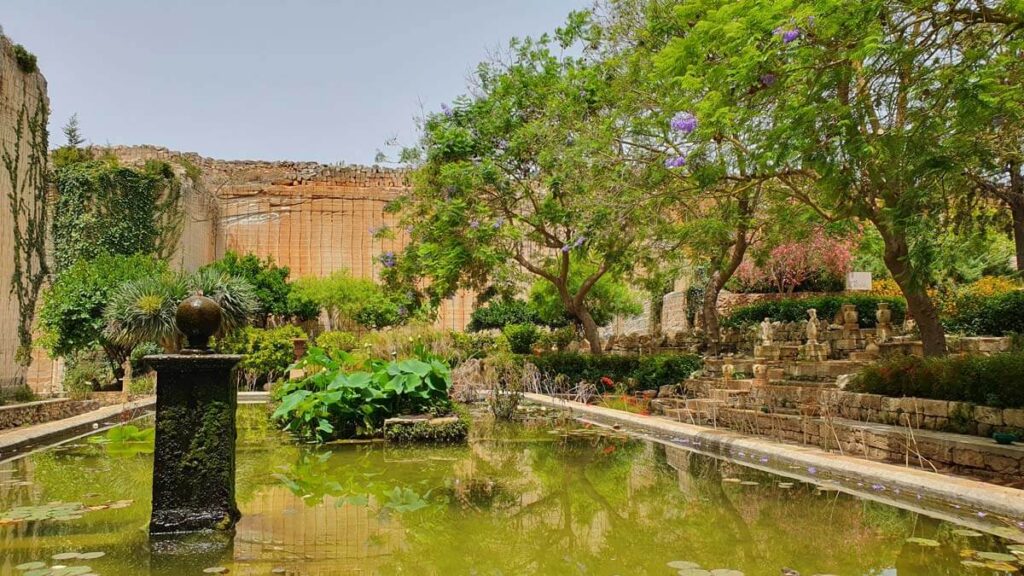
One of the most breath-taking experiences of my most recent stay on Favignana was visiting the ‘Impossible’ garden in the middle of the eastern half of the island. The Giardino dell’Impossibile is so-named because when owner Maria Gabriella Campo spoke of her plans to create a garden in this stretch of arid quarry, islanders told her it was impossible. But she persevered and now island visitors can come to be amazed at this unexpected paradise.
The Giardino dell’Impossibile is an absolutely magical place, and adds a completely different element to a traveller’s experience of Favignana. I’d recommend allowing plenty of time, ideally more than an hour, to enjoy the garden at your leisure. A self-guided tour, equipped with audio-guide or written pamphlet (in excellent English) takes the garden visitor along a trail through different spaces and planting. This guide doesn’t just cover the planting and garden design; it also includes a lot of information about the quarrying industry on the island and the techniques used, evidence of which you can see here, as well as throwing other sidelights on the island’s history. I found it fascinating.
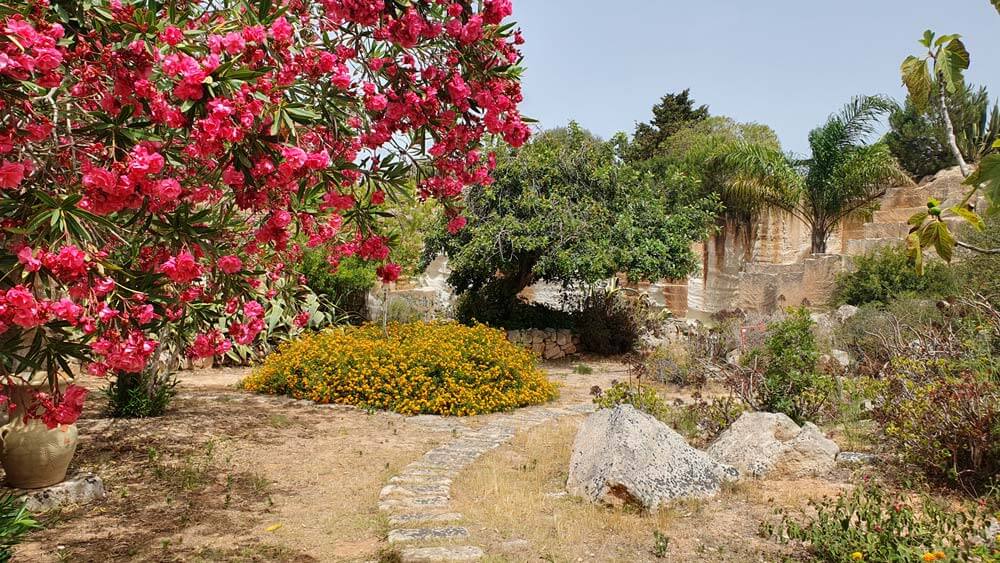
The tour begins on the quarry’s edge, with views down into the spaces you will explore later, before descending into a labyrinthine network of old quarries. The environment is hot, dry and dusty, which obviously limits the amount of greenery and type of garden which can be created here. So the designs work with the pre-existing natural and man-made (quarried) surroundings, creating an impressive variety of planting and scenography.
The visitor moves between different garden ‘rooms’, through the occasional short tunnel or arch. We pass deeper caves where artworks and decorative features have been installed, often reflecting aspects of the island’s heritage and the owners’ lives. One highlight is the Grotta dello Zu Sarino, a cave dedicated to Favignana stonecutter-turned-outsider-artist ‘Zu Sarino’ (read my blog about Zu’ Sarino). The greatest theatrical spectacle comes at the end, with the entrance into a great, open area of quarry filled with greenery and water features.
If you are interested in gardens or unusual landscapes, or are simply interested in developing a deeper understanding of Favignana, the garden is an essential visit. Admission isn’t cheap, but I’d say it’s well worth it. Check the opening times and consider booking ahead: giardinodellimpossibile.it/. The audioguide can be downloaded to your phone, so keep some battery charge and take headphones – or use the written alternative, as I did.
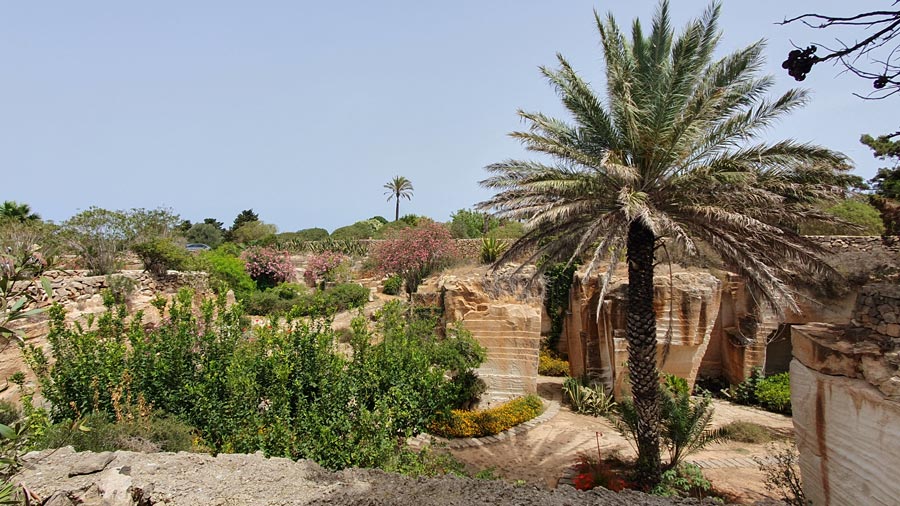
Walking and the Forte Santa Caterina
The distances on Favignana are small enough that walking is a feasible way of seeing the island, though a bicycle is definitely more fun and more time-efficient on the long and mostly flat stretches of road. My last visit was in June and it would have felt uncomfortably hot to walk far under the baking sun. There is little shade on the island.
The best walking excursion from Favignana town – and the most obvious – is up to the hilltop castle on the ridge which dominates and divides the island. The hiking route is straightforward – past the beach and out along a straight road from town, then zig-zagging up a paved stepped path. It is quite a climb, but nevertheless a popular outing in the late afternoon, once the heat of the day has lessened.
The fortress, called the Forte di Santa Caterina, is officially closed to the public, though on my visit, during my first stay on the island, it was easy to enter the decrepit building and explore its extensive interior and terraces, all crumbling away in a state of abandonment. Dating from Norman times, and extended under the Spanish in the seventeenth century, the fortress is in a breath-taking location. The views from up here, on the ridge separating the island’s two halves, are worth the walk.
Boat trips, diving and fishing
The Egadi islands are intimately connected with the sea which surrounds them, and touring by boat is an obvious and attractive option. It’s possible to hire your own boat, or to join an excursion. At weekends and in the summer you are likely to be propositioned by boatmen around the harbour, offering boat trips around the island or to beaches. Otherwise, ask at your hotel or one of the offices in town advertising boat excursions.
Organised boat trips from the mainland and from Favignana offer visits to the other two inhabited islands Levanzo and Marettimo. However you can reach these by public ferry too, and it’s straightforward to plan day trips based around the ferry timetables. I’d strongly recommend visiting both of the other Egadi islands when you’re staying on Favignana if you have time; each island has very different scenery and character to experience.
Scuba-diving and snorkelling are popular activities around all of the Egadi Islands; the clear, clean waters are protected by a marine reserve. There are diving centres in Favignana town which organise excursions and lessons. If you are keen on fishing, or are interested in local traditions, you could consider joining a fisherman on a fishing trip – look out for signs advertising pescaturismo.
Getting around Favignana
If you don’t fancy cycling or walking, it is possible to hire other vehicles such as scooters, open-top buggies and cars at rental offices by the port. The island also has a bus service, with three routes which enable you to reach most parts of Favignana. Note though the buses don’t run often and you’ll need to fit around their timetables, which are seasonal. The latest timetable and route details should be on Favignana council’s website; at the time of writing services are operated by Tarantola & Cuffaro, who publish timetables on their Facebook page.
An entertaining alternative way of touring the island in summer is to take the trenino, a little tourist ‘train’ which trundles around the island’s roads. Leaving from the port, the train has different routes, including a long circuit which visits the western half of the island (egadilandia.it/). A more staid option is to take a taxi or mini-bus tour around Favignana; you’ll see adverts for these around town.
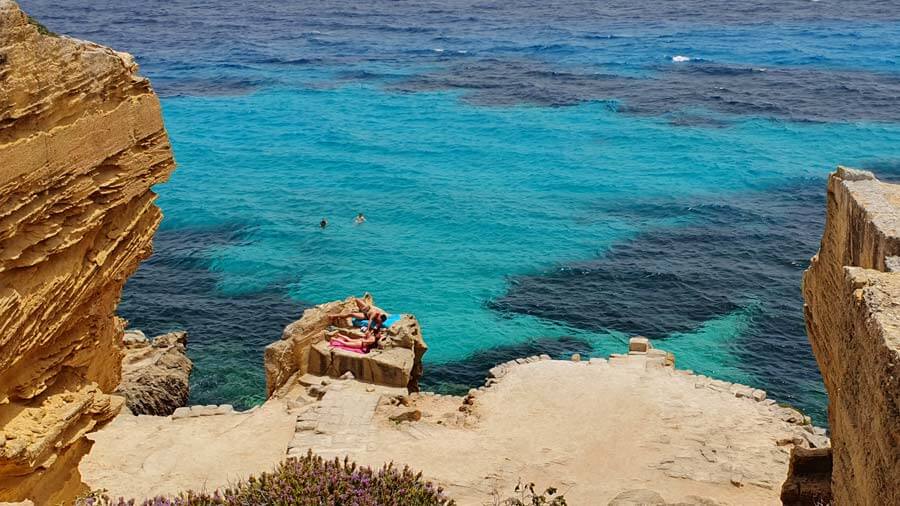
Shops, restaurants and services
Favignana is sleepy at times, but the town is the centre of the island community and after the afternoon siesta it comes to life. A good range of food shops open their doors, from a fishmonger, selling tuna with today’s price scrawled on a paper notice, to souvenir food shops for tourists selling all kinds of local specialities (frequently tuna).
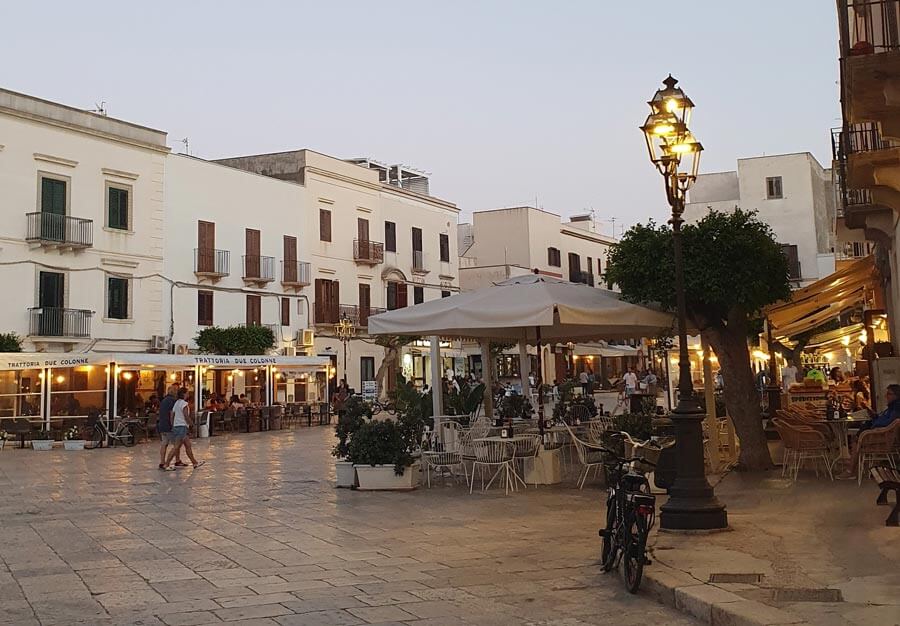
For a sit-down restaurant meal there is a good choice in Favignana, and prices are reasonable, considering the island location. Fresh seafood is of course a speciality (look out for the seafood and pistachio pasta dishes), but you’ll also find traditional Sicilian dishes like pasta alla Norma, as well as modern Italian and international cuisine. Via Vittorio Emanuele in the heart of town has become a little tourist parade, lined with restaurants, bistros and bars. Osteria del Sotto Sale is a popular option here, as its nearby, smarter sister-restaurant, Ristorante Sotto Sale (https://www.sottosale.com/en/, book ahead). Heading up Via Roma, Locanda 23 has cute outdoor tables and a blackboard listing its seafood menu.
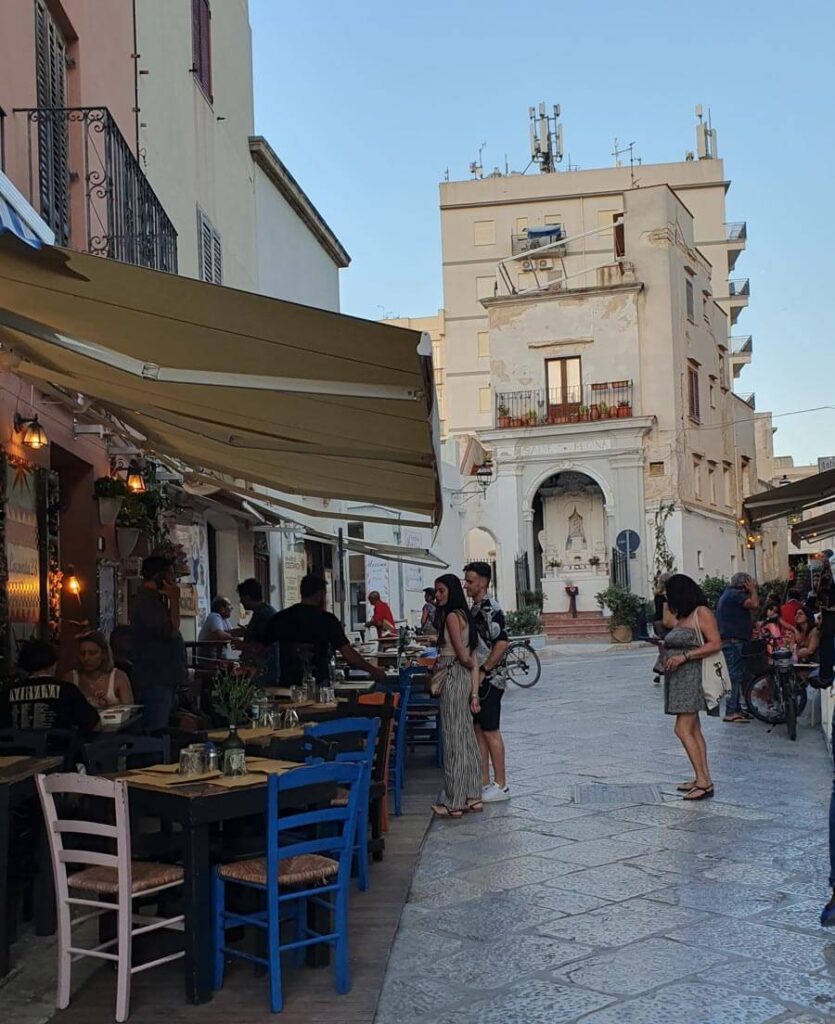
If you haven’t booked ahead, are on a budget or just looking for something quick and easy, try a take-away pizza from somewhere like Pizza Pazza on Via Giuseppe Mazzini. I ate my buffalo mozzarella pizza on a bench outside the take-away; a tasty low-cost meal. Other street food destinations include Santi e Marinai, opposite Villa Florio, which sells octopus burgers, arancini and fish sandwiches. Another good place to buy a good, cheap meal on the go is Panificio La Madonnina, a little bakery uphill from Piazza Madrice which sells small take-away pizzas as well as delicious Sicilian pastries.
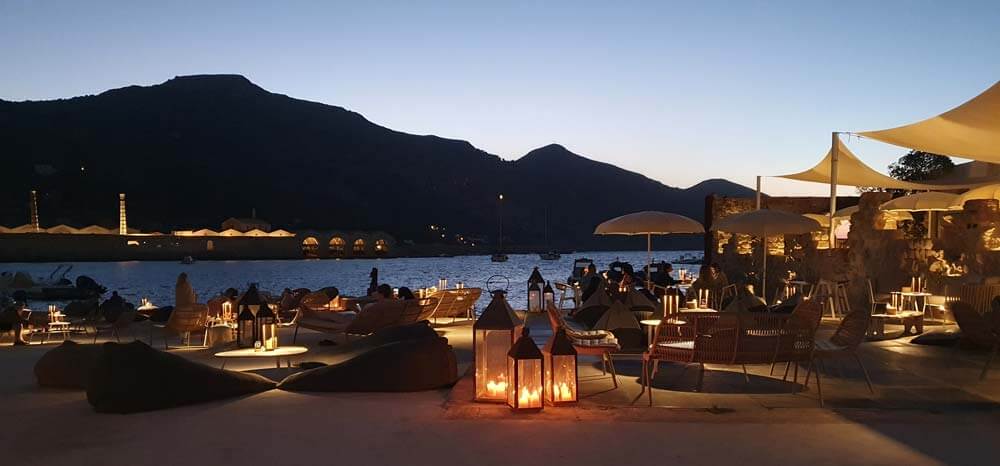
I ended my day on Favignana with a sunset aperitivo at Camparìa. This chic restaurant/cocktail bar/events space is located in a restored complex that was part of the Florio tuna fishery. Surrounded by island heritage and waterfront views, it’s an evocative spot with a stylish contemporary vibe. This is definitely not the unpretentious, traditional face of island hospitality, it’s expensive by local standards, and I’d recommend checking the latest reviews(!) but visitors may find it worth splashing out on a visit to enjoy the setting, if only for a coffee. I didn’t regret visiting, even though my glass of wine cost the same as the take-away pizza I enjoyed that evening.
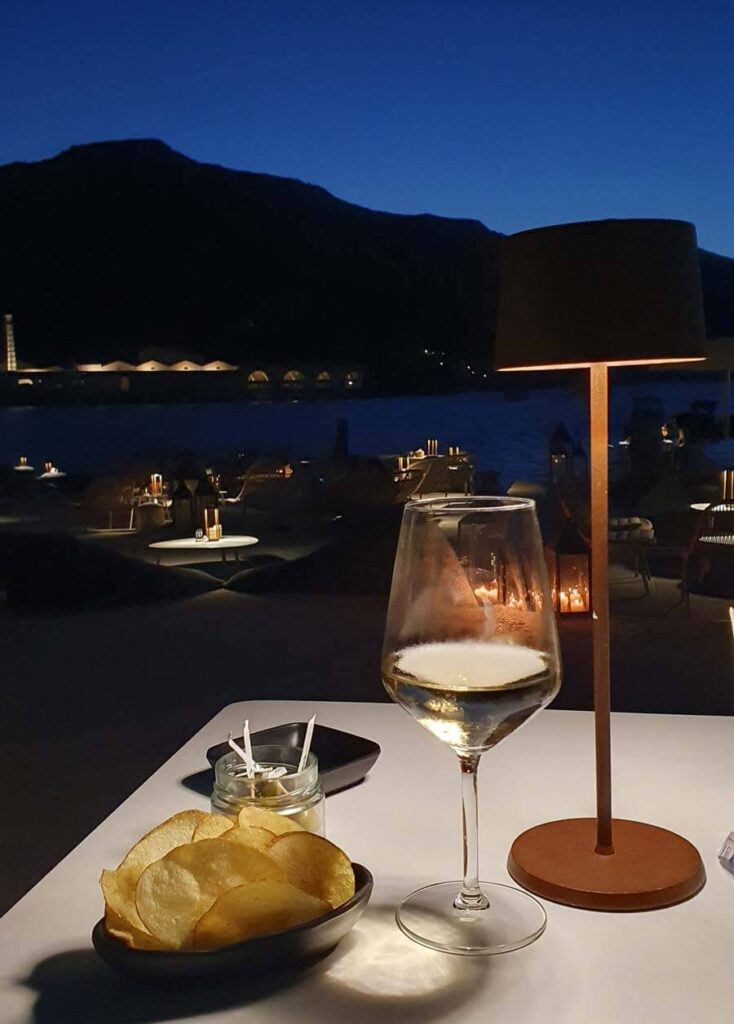
Travel to Favignana
Favignana is the principal island of the Egadi archipelago and it is well-connected with the other islands and with Sicily, with many daily services to Trapani and several ferries to Marsala. By hydrofoil Favignana is only thirty minutes or less from Trapani (the island of Levanzo is frequently an intermediate stop). Ferries are operated by Liberty Lines.
From Trapani airport, take the direct bus or a taxi to Trapani port. You can buy ferry tickets in advance online (I bought mine at the airport bus stop, once I’d worked out what ferry I’d arrive in time for), or at ticket kiosks at the port. At peak times (the height of summer, day-trip hours) I’d recommend booking ahead to be sure of getting onboard.
Favignana can be visited on a boat excursion from Trapani, or as a day trip destination by public ferries. Plenty of visitors arrive this way, flooding off the ferries, some already in beach gear. However, to truly appreciate the island and make the most of all it has to offer, you really should stay overnight and explore at a leisurely pace. On my first visit we stayed on Favignana and made day trips to Levanzo and Marettimo, although these didn’t allow as much exploration time as I’d have liked. On my second trip I stayed on Favignana first and then moved on to Marettimo for several nights, a spot of island-hopping which gave me lots of enjoyable variety.
Where to stay on Favignana: Accommodation guide
Favignana has a good choice of accommodation, from hotels to holiday apartments. I’d recommend booking well in advance for the best choice of places to stay, though you may still be lucky at short notice. If you book through the links here, which are affiliate links, you’ll be supporting this website, while not paying any extra. Thank you.
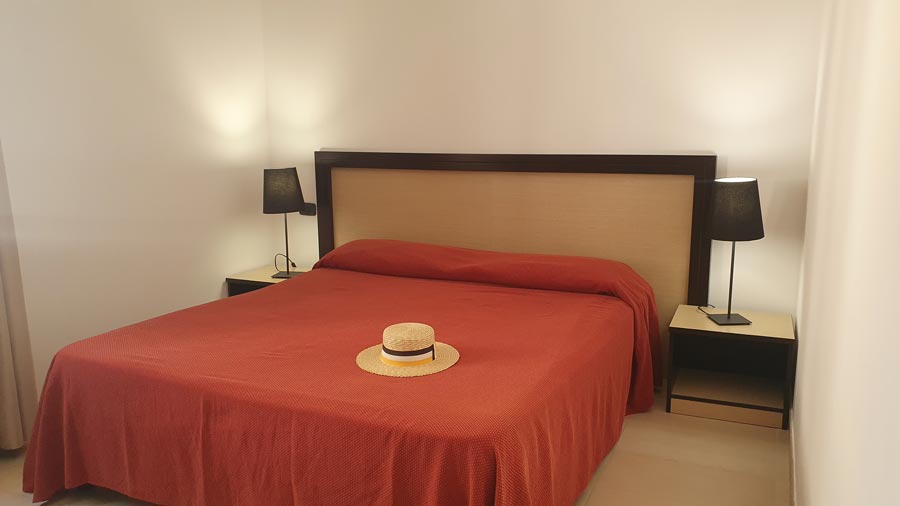
I’ve stayed twice at Hotel Il Portico, close to the ferries and Piazza Madrice, a comfortable, super-convenient and welcoming place to stay. I found it very friendly, with staff who provided useful advice, friendly service and delicious homemade pastries for breakfast. Once they realised I particularly enjoyed the pistachio delicacies, they pressed so many on me that I became concerned about over-eating before my bike ride. I could have stayed more cheaply elsewhere but I found Il Portico’s location and services worth paying for, while still reasonably priced.
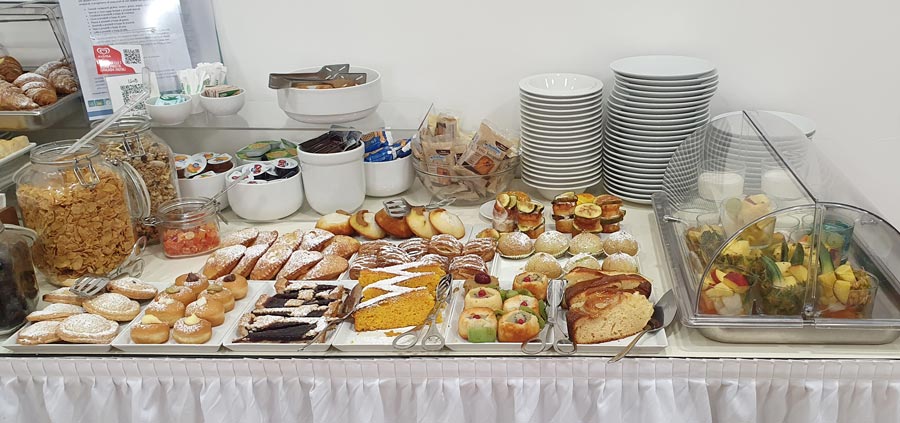
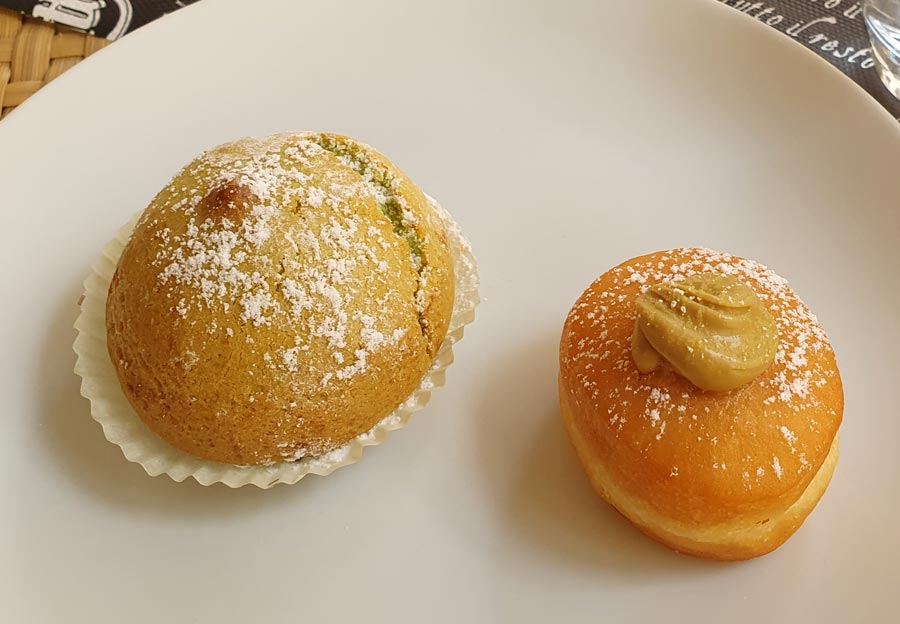
Cheaper island options include holiday rental apartments for those prepared to be more self-sufficient, and simple B&Bs, some of them outside the town.
Good-value central choices include B&B Il Tufo (ideal for the port), La Casa del Limoneto (B&B with rooms around a little citrus garden) and Albergo Bouganville (further from the heart of town but still convenient).
If you don’t mind staying out of town, a bike or taxi ride away from town and coast, you can actually stay at the gorgeous Giardino dell’Impossibile, at the simple Villa Margherita Residence. Other picturesque rural accommodation for a peaceful stay includes the lovely-looking Masseria Il Passo, on the western side of the island.
High-end options include Il Baglio sull’Acqua, with a swimming pool and just outside the town, and the very central, stylish I Pretti Resort. Setteminne Resort Design has a modern aesthetic and some outdoor space.
Characterful choices include Cave Garden Rooms, built into one of Favignana’s quarries.
Beach-lovers might enjoy Stabilimento Lido Burrone, where accommodation is right alongside the island’s sandy beach.
> More accommodation on Favignana
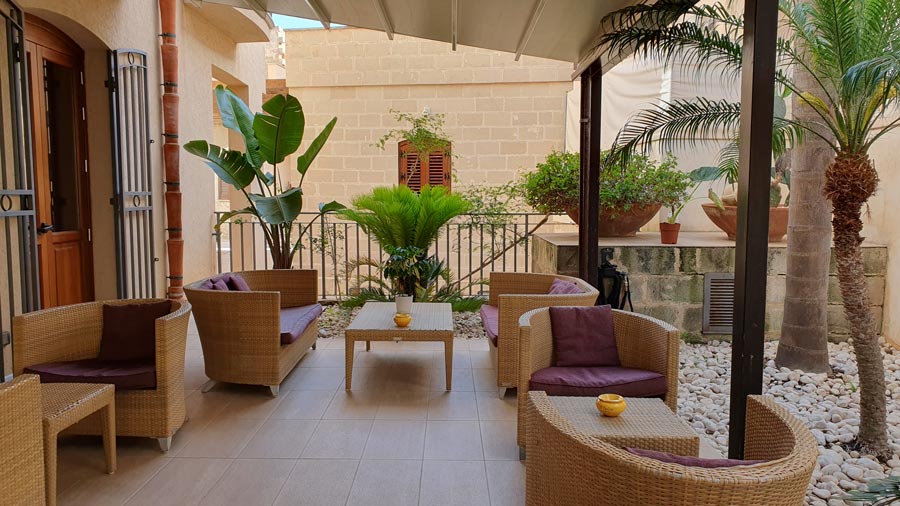
On this site
Outsider art on Favignana: discovering the story of ‘Zu’ Sarino’
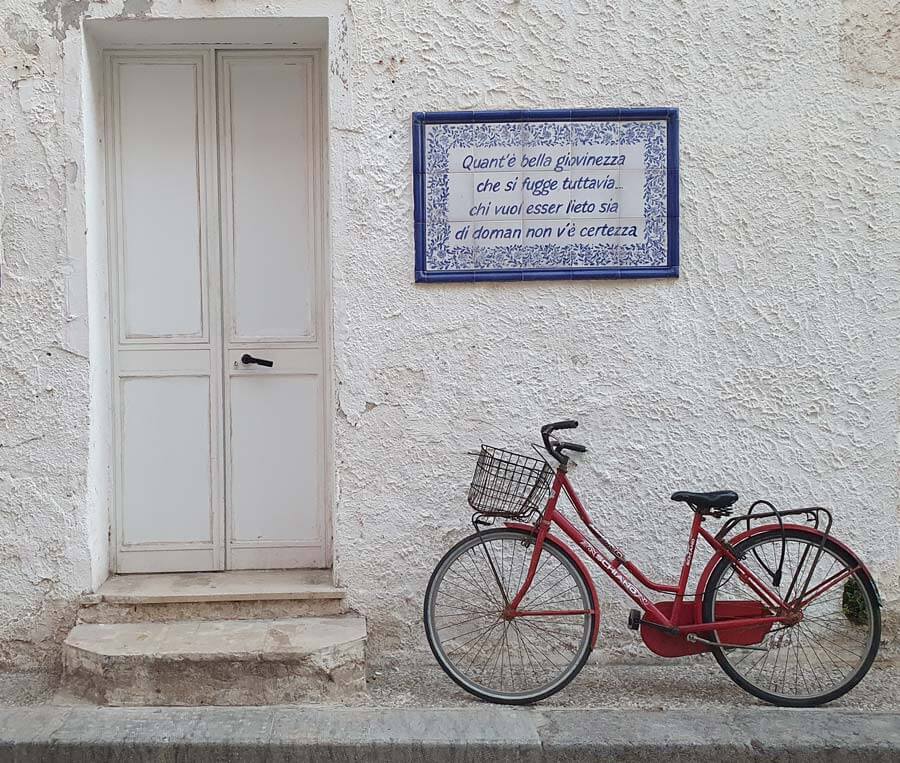
Photographs from my first trip to Favignana (2010)
I first visited Favignana back in May 2010 when I took my parents on a tour around western Sicily. We stayed on Favignana and visited the other Egadi islands by boat. The islands were already tourist destinations then, of course. But since that first visit, like almost everywhere in Italy, Favignana and its island siblings have become much more touristy.

I wrote: Although there are tourist amenities, the island’s character seems little-altered, and travellers who come here are happy to fit in with the leisurely island way of life.
Where we found a very local and authentic low-key vibe, there are now rows of bars and eateries with a more international feel aimed fully at tourists, including one or two very smart places to eat and drink. The number of visitors who had cycled their way to Cala Rossa and climbed over the rocks surprised me that first time – but the numbers were tiny compared to the crowds I found on this second visit (to be fair, it was also a month later into the year). Stacks of bikes and scooters, crowds spread over the rocky cliffs and in the sea, a huge number of boats moored off-shore …
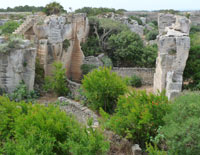
The atmosphere on the islands is still fairly low-key as tourist destinations go. Most visitors were Italian families or young(ish) people happy to hike, bike, swim and boat. I found it very interesting to see the changes though, which must have brought considerable prosperity to at least some Egadi islanders, while altering its character in ways that perhaps not all appreciate.

